Surgeon

Philip S. Schoenfeld, M.D., F.A.C.S.
Physician View profile page

Procedures: Rhinoplasty Before and After Photos

Physician View profile page
"*" indicates required fields


Trustindex verifies that the original source of the review is Google. Greatly improved my quality of life. Dr. Schoenfeld was very knowledgeable and answered all my questions. I would trust him to perform this surgery again.Trustindex verifies that the original source of the review is Google. Dr. Schoenfeld is amazing. I’ve seen him for both cosmetic and sinus related reasons and he is truly the best - I can breathe better than I ever have. so glad I found him! thank you, Dr. Schoenfeld.Trustindex verifies that the original source of the review is Google. Upon meeting Dr. Schoenfeld, I immediately knew I was in good hands. He was incredibly informative, respectful, and receptive to my requests and concerns. I felt entirely prepared for my operation and healing process. He and his team frequently checked in pre-op and post-op to ensure my comfort, safety, and satisfaction. Almost 2 months post-op, my health and confidence has significantly improved. My recovery was incredibly smooth and rapid to the extent that I feel as though I never even had surgery. He absolutely exceeded my expectations without any surprises and executed on every promise he made. I am so grateful for Dr. Schoenfeld and strongly recommend him and his team!Trustindex verifies that the original source of the review is Google. Terrific experience - wonderful facial by a lovely and talented anesthetist.Trustindex verifies that the original source of the review is Google. I haven't left a review for anybody but I am doing this for Dr. Philip Schoenfeld to express my appreciation for the exceptional care I received after fracturing my nose during martial arts training. The injury was quite severe, leaving my nose crooked and significantly impacting my breathing. Dr. Schoenfeld assessed my situation promptly and recommended surgery to restore my normal breathing. Getting an appointment within the same week was also incredibly helpful. The surgery was a complete success, and I am so pleased with how my nose looks. What has surprised me most is the significant improvement in my breathing - I can breathe more easily now than I ever have before! Thank you so much for your astonishing work.Trustindex verifies that the original source of the review is Google. Dr. Shoenfeld is fabulous! Very detailed and listens to what the patient wants/needs. I’d give more than 5 stars if I had the option!Trustindex verifies that the original source of the review is Google. 2025 - I’ve been going to Dr. Schoenfeld since 2023, and I truly can’t imagine trusting anyone else with my face. I recently came back for cheek filler, lip filler, and a little liquid rhinoplasty to refine the tip of my nose —and I’m completely obsessed with the results. As someone who’s normally terrified of needles, Dr. Schoenfeld makes me feel so comfortable and at ease every single time. His technique is gentle, his eye for detail is unmatched, and he really listens to what you want. His entire office staff and front desk team are incredibly kind and accommodating, which makes the whole experience even better. I can’t recommend him enough! 2024 - Update after rhinoplasty - Saw Dr. Schoenfeld for lip filler & cheek filler. I am absolutely obsessed with the results and can see the difference immediately after. His front desk team is so kind and polite - they made scheduling a super easy and convenient process again. Filler was practically painless. 10/10 experience. I will definitely be coming back!! 2023 - Dr. Schoenfeld is incredible. I had an amazing experience and highly recommend him for all rhinoplasty patients. I went to him for a septoplasty and ethnic rhinoplasty. The procedure itself was painless and downtime was minimal. His team was able to fit me in within weeks for the procedure and follow-up appointments— super easy scheduling and consultation process. I definitely saw a noticeable difference after the procedure. The results are fantastic and everything I could wish for!!! Dr. Schoenfeld addressed all of my concerns and made me feel super confident and supported throughout the entire process— terrific bedside manner.Trustindex verifies that the original source of the review is Google. I was recommended to Dr. Schoenfeld by an EMT doctor after a second broken nose. I needed a septoplasty/ rhinoplasty. I googled a few other surgeons after, but after having met Dr. Schoenfeld, I knew I was in the right hands — physically and emotionally! His work speaks volumes, but the concern and understanding he brings to his patients’ desired outcome is quite reassuring. After my procedure, I’ve had a few concerns after accidental head bumps (3 yr old!), and his office staff was wonderful and helpful to squeeze me in asap (thanks Ana! (Sp?)). I wholeheartedly would advise considering Dr. Schoenfeld for any ENT needs. Wonderful person, incredible surgeon, amazing staff.Trustindex verifies that the original source of the review is Google. I cannot rave about Dr. Schoenfeld enough. I had a rhinoplasty and septoplasty done 12 years ago with him and it has stood the test of time. Matter of fact, I just saw him today and he even mentioned how amazing my results were after all of this time. Most people don't even know I've had any work done and I believe that is the true testament to Dr. Schoenfeld's artistry. He listens to your concerns, makes his expert recommendations, and follows through with amazing work. He also doesn't push anything on you and will actually tell you if something needs to be done or not. I highly recommend Dr. Schoenfeld and hope that he can bring an improvement to your life as he has done mine.Verified by TrustindexTrustindex verified badge is the Universal Symbol of Trust. Only the greatest companies can get the verified badge who has a review score above 4.5, based on customer reviews over the past 12 months. Read more
"*" indicates required fields